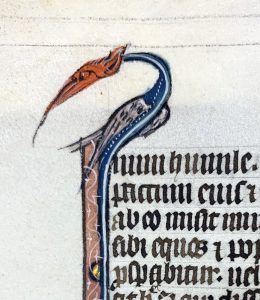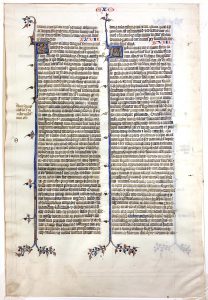Otto Ege’s
Aquinas Manuscript in Humanist Script
(Ege Manuscript 40)
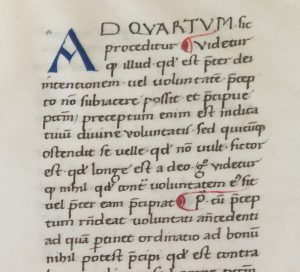
Private Collection, Ege’s FBNC Portfolio, Aquinas Leaf, Recto, Top Right. Reproduced by Permission.
PART II
Before and After Ege
We continue explorations of Ege Manuscript 40, as we began in Part I, in a series of posts about Ege manuscript fragments in his Portfolio of Famous Books in Nine Centuries (FBNC).
The series began with
See also our Contents List.
Now we turn to Part II on Otto Ege’s Aquinas Manuscript in Humanist Script. Its specimen leaves circulate not only in the Portfolio of Famous Books, in the longer, Deluxe Version in Nine Centuries, but also in the more famous Portfolio of Fifty Original Leaves (FOL) from Medieval Western Manuscripts. The Aquinas Manuscript takes its assigned Ege Manuscript Number from its place as Specimen Leaf Number 40 in the FOL Portfolio.
Ege’s Label for Manuscript Specimen 40
in the FOL Portfolio
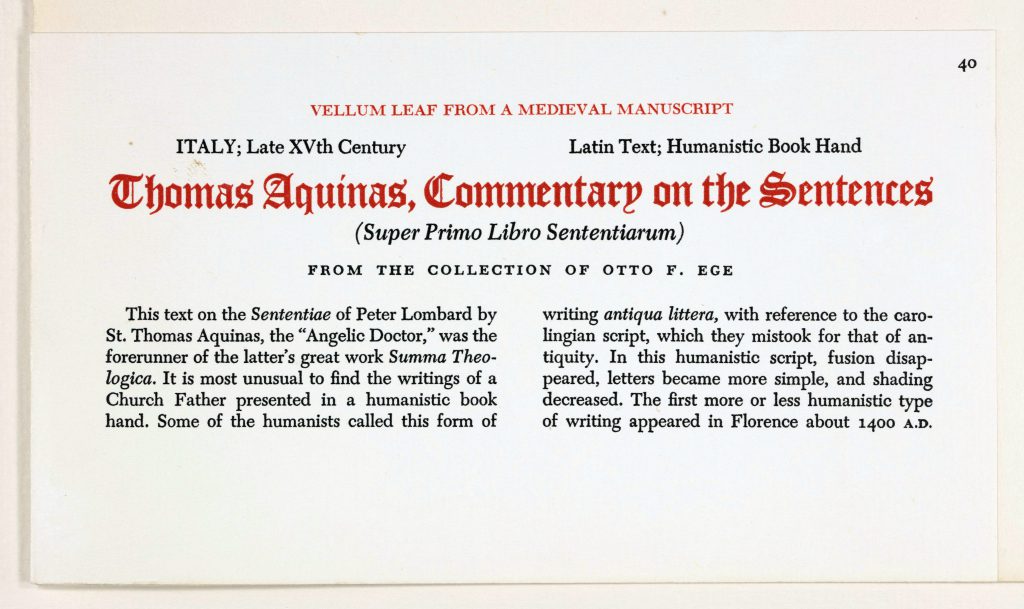
Otto F. Ege: Fifty Original Leaves from Medieval Manuscripts, Leaf 40, Printed Label, Special Collections and University Archives, Stony Brook University Libraries.
Ege’s Label for the Specimen Leaf in the Famous Books Portfolio in Nine Centuries
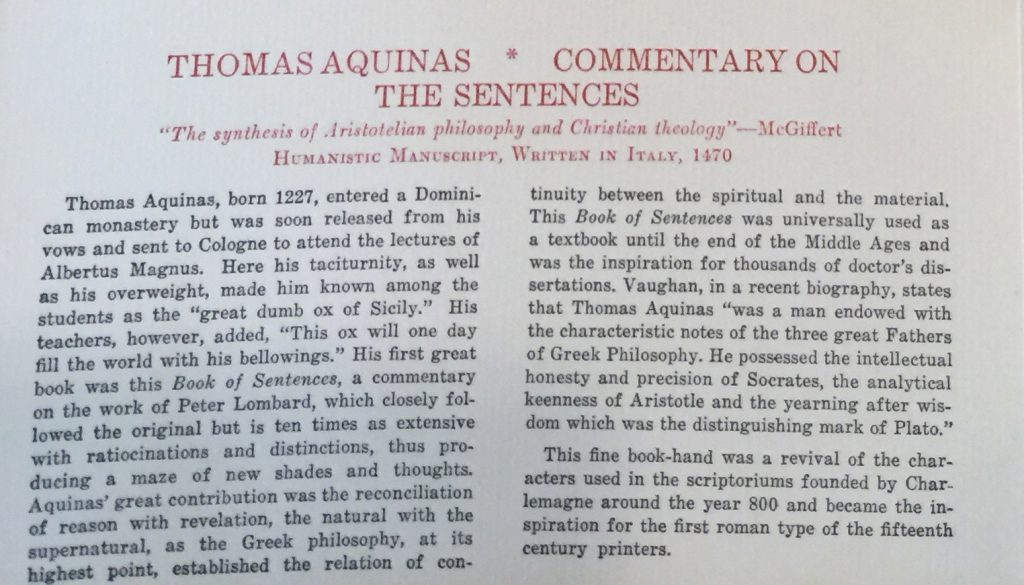
Private Collection, Ege’s Famous Books in Nine Centuries, Label for the Aquinas Manuscript Leaf. Reproduced by permission.
Ege’s Label for the Specimen in the (Unnumbered) Contents List for FBNC
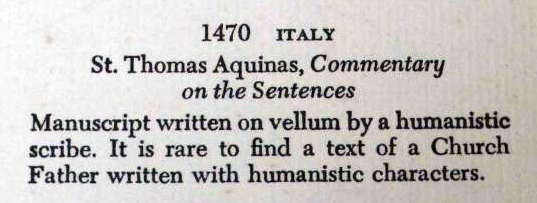
Private Collection, Ege’s FBNS, Contents List, Detail: The Aquinas Manuscript. Reproduced by permission.
Part I in our series on Otto Ege’s Aquinas Manuscript in Humanist Script (Ege Manuscript 40) examines these labels as such.
Specimen Pages
Examples from among the specimens displayed in Part I show several approaches to the layout of the text in 2 columns of 37 lines. Many of Ege’s specimens selected for the Portfolios show ‘standard’ pages, with script in Humanist Minuscule, Paraph markers in red and blue, and inset Capital Letters in blue or red.
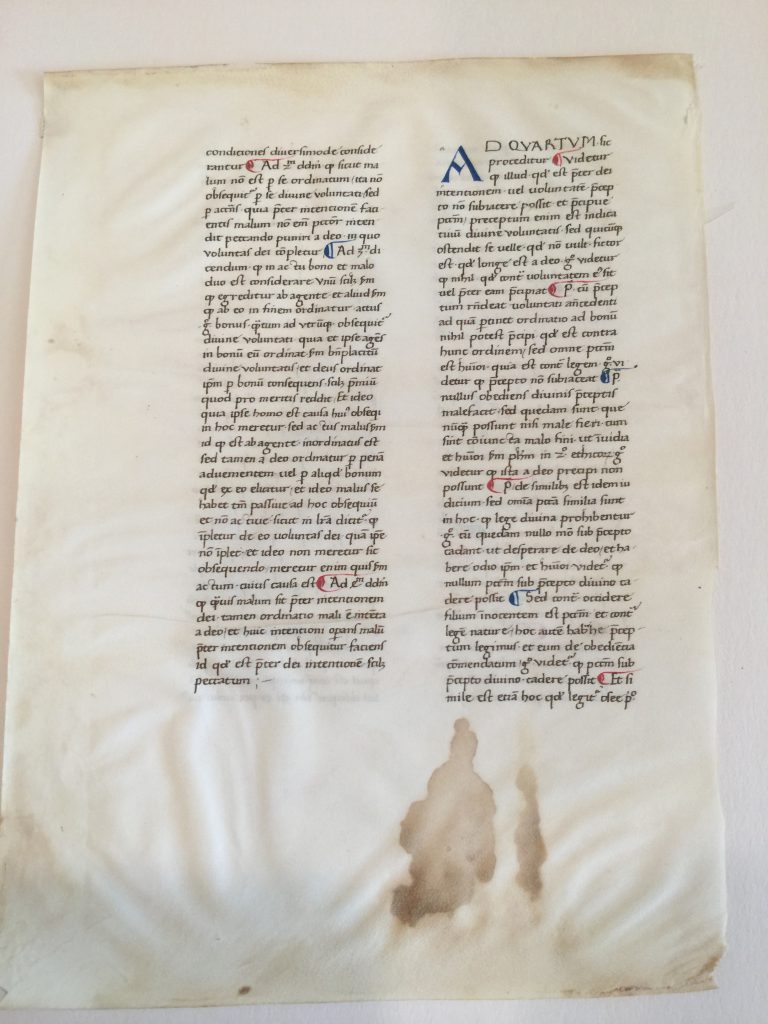
Private Collection, FBNC, Aquinas Leaf ‘Recto’. Reproduced by permission.
Some specimens provide somewhat more elevated forms of polychrome decorated initials, including rectangular frames, gold elements, and patterns of dots.
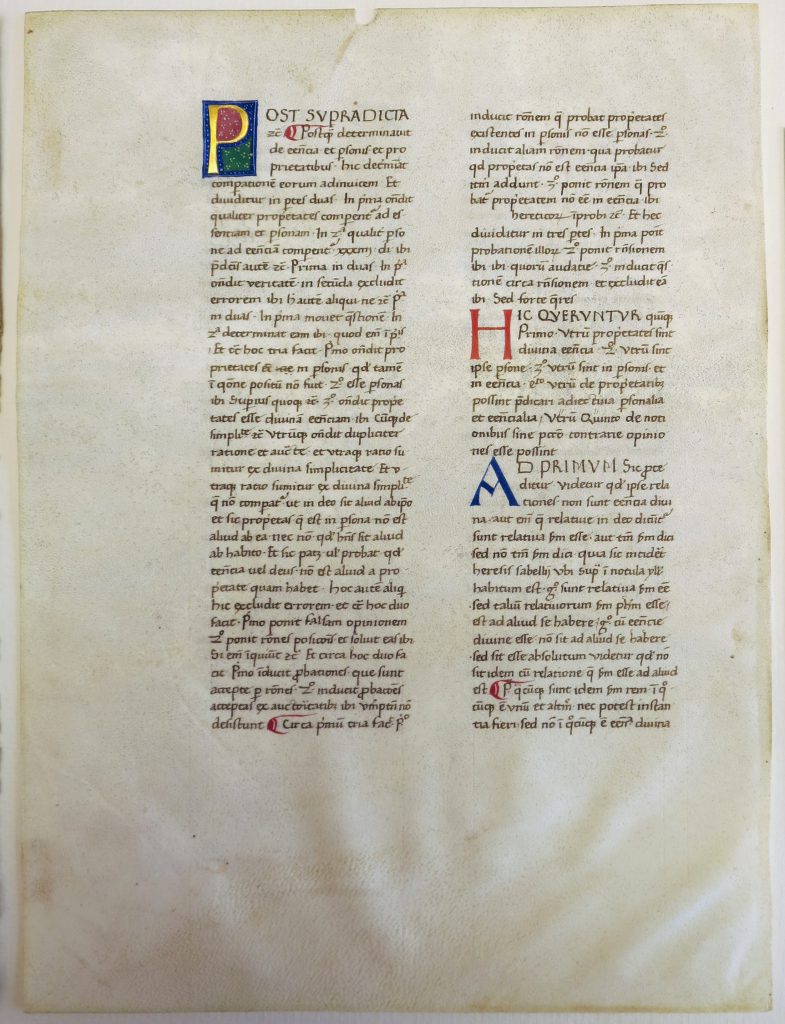
Beinecke Rare Book & Manuscript Library, Otto Ege Collection, FOL Set 3, MS 40, Specimen 2 = folio 216v (turned to the front in Ege’s Mount. Photography Mildred Budny.
The Manuscript Before and After Ege
As frequently in studying manuscripts dispersed by Ege, sales and auction catalogues can provide invaluable information about the states of the manuscript in transmission across time, hands, and collections. Frequently, too, it can be challenging to try to identify the catalogues, and to find access to them. Part of the problem can come from abbreviated citations in reference works to catalogues only by a vendor’s name, a year-date, and/or a catalogue or bulletin number.
For example, with Ege MS 40, “Maggs, Bulletin 11 (1982)” stands for
- Maggs Bros, European Miniatures and Illumination & Calligraphy also early writing from Egypt, Bulletin No. 11 (London: November 1982), item 79 and pl. XXXIII.
“Maggs Cat. No. 1227 [without a date]” stands for
- Maggs Bros., Ltd., Illuminated Leaves and Mediaeval Miniatures, Catalogue 1227 (London: 1997), item 96.
I await the chance to see these items, whilst libraries are shut or difficult of access in the years 2020–2021.
Meanwhile, some online reference sources help somewhat to identify which are the correct catalogues, and which collection might have them, or grant access to them, even in digital form.
Earlier catalogues are also sought. They may report information about the manuscript in its former volume.
Duschnes, Catalogues 54 & 74 (1945–1946)
I’m on the lookout for:
- Philip C. Duschnes, Catalogue 54 (1943), item 50
- Philip C. Duschnes, Catalogue 74 (1946), item 50 — perhaps the same item, which continued to await sale?
The former, Catalogue 54 [53?], is “101 Original Leaves & Sets of Leaves from Medieval Manuscripts, Incunabula, Famous Bibles and Noted Presses, 1150 A. D. – 1935 A. D.” [Autumn 1942]. The front cover is illustrated here, in connection with Ege Manuscript 15 (the renowned Beauvais Missal).
Sotheby’s, 26 November 1985, Lot 80
- “Sotheby’s 1985, lot 80” is identifiable with a catalogue already on my bookshelves, as it contains many lots (fifty-four in total, nos. 39–89) left over from Ege’s collection, including manuscript fragments of various kinds and in various states.
The catalogue presents Western Manuscripts and Miniatures for sale at auction in London on Tuesday 26th November 1985. Its Lot 80 offers
THIRTY-TWO LEAVES FROM THOMAS AQUINAS, COMMENTARY ON THE SENTENCES OF PETER LOMBARD, BOOK I, IN LATIN, MANUSCRIPT ON VELLUM [ITALY, SECOND HALF OF THE FIFTEENTH CENTURY
32 leaves, detached, double column, 37 lines, . . . written in brown ink in a humanistic hand with some gothic features, first words of each chapter in capitals, paragraph marks throughout in red or blue, PAINTED INITIALS (3-line) in red or blue at the start of each chapter . . .
The entry includes the tantalizing reference to an earlier catalogue (as yet unidentified), which presents the manuscript in its former state, binding included.
With a cutting from an American bookseller’s catalogue in which this manuscript, then with 309 leaves, was no. 12 (Emphasis added), describing a coat-of-arms on the first leaf, azure, 3 crescents or between a chevron of the same [Emphasis added], “probably the work was commissioned by some beauty-loving Italian duke . . . Certainly the work of the good saint have never been sent forth into the world in lovelier garb”, etc., with much more . . . ‘ “
An Observation on the Usefulness of Sales Clippings
The mention there of a former sales clipping which continued to travel in the company of the manuscript reminds me of the pair of clippings (from a single, unnamed catalogue) pasted at the front of Volume II of Ege Manuscript 51, now at the Beinecke Rare Book & Manuscript Library.
The partly overlapping pair of clippings comes from consecutive pages in the lost catalogue, as the entry carried over from the bottom of one page (and leaf) to the top of the next, so as to complete the account of item 443. The catalogue remains unidentified; the overlap covers, or veils, the price of £21 at the end of the item. The entry describes the 3-volume set of Aristotelian texts before Ege took it to pieces.
Specimens from the Aristotle manuscript found their way into the Portfolios of Famous Books, in both Nine Centuries (like the Aquinas Manuscript) and Eight Centuries. See Volume II and More Parts of Ege Manuscript 51.
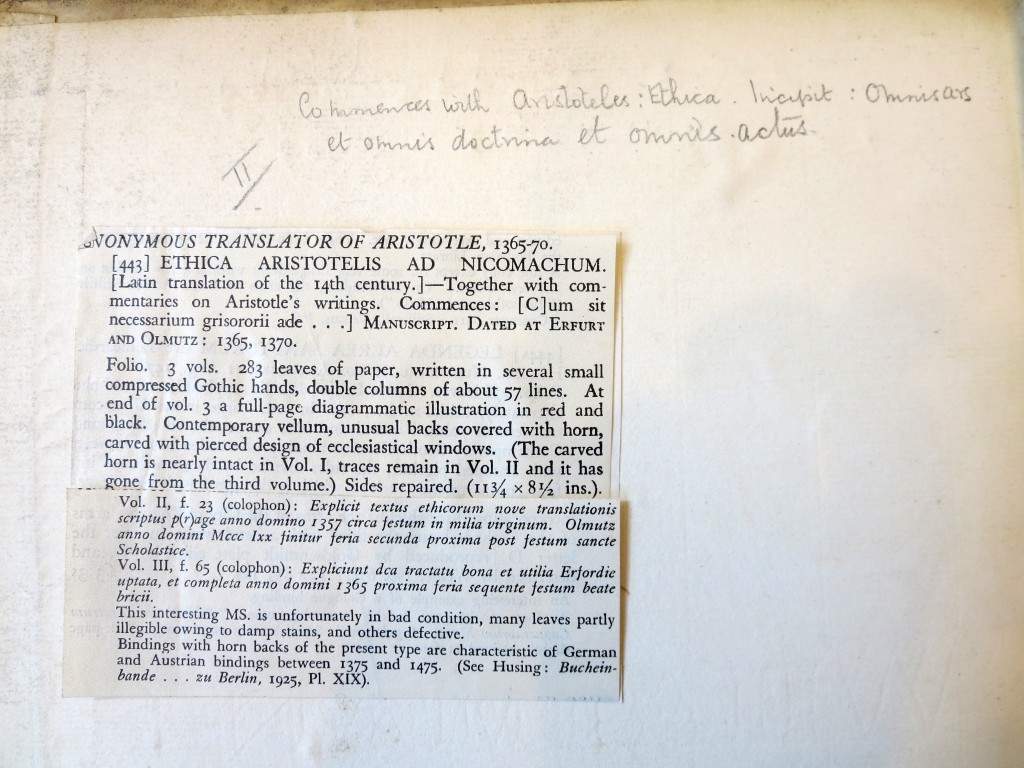
Beinecke Rare Book and Manuscript Library, Yale University. Otto Ege Collection, Ege Manuscript 51, Volume II, Front Pastedown, Top.
Inspired by the description in the Sotheby’s catalogue, I have found one or more possible earlier sales catalogues for the Aquinas manuscript — although it is not by an “American bookseller”, nor does its item number correspond with the reported number 12.
Davis & Orioli (1924 & 1925)
Two relevant entries appear in the Schoenberg Database of Manuscripts, although their records assimilate the details of the original catalogues in the requirement to conform with the format and fields designed for data entry and retrieval.
1) SDBM_262153
I. Davis & G. M. Orioli, Number 41 (1925), Rare Books & Interesting Manuscripts, Lot #4. Price 65.00 GPB
“Aquino (S. Thomas de)”, Super primo libro sententiarum, XVth century, parchment (fine vellum), Italy 310 folios, 37 lines, 2 columns
Binding: “rich-coloured brown morocco elaborately tooled in blind to a Veneto-Oriental design heightened with pointille decorations in gold”
Other info: “arms of owner within green wreath in lower margin”
2) SDBM_261443
I. Davis & G. M. Orioli, Number XLIV (1926), Early Printed Books: Literature, Science, and Medicines, Lot #1. Price 65.00 GPB
[Etc., as before]
These records conjure up the image of a volume prepared on “fine vellum” with the requisite number of columns and lines, with a tooled leather binding embellished in “a Veneto-Oriental design” including pointillé elements in gold, and an image of the owner’s arms (or coat-of-arms) in a lower margin someplace on the inside, presumably, as customary, on the frontispiece or first page of text.
From an Origin in Italy
To Collections in the United States (and Beyond)
That the firm of Davis & Orioli had offices in Florence, Italy (after 1910), and in London, England (after 1913), opens the possibility (or likelihood?) that the manuscript came to the firm from some source directly in Italy. Perhaps the manuscript of Aquinas’s Commentary on the Sentences, or at least the specified Book I, resided in Italy for several centuries between its production in the 15th century and its departure for other lands, presumably via London, by the start of the second quarter of the 20th century.
The early sales catalogues themselves could have more to tell about the manuscript in its former state than their database “skeleton” reveals.
The Number(s) of Leaves
Already, however, it seems clear that ‘our’ folio 300 in the new set of FBNC occupied a position near the end of the volume, although reports of the total number of leaves in the volume differ somewhat. The Schoenberg Database entries for the 1925 and 1926 catalogues of Davis & Orioli report 310 leaves, whereas the “American bookseller’s catalogue” (of an unknown date) quoted by the Sotheby’s catalogue of 1985 cites 309 leaves. The numbers could well indicate that the pencil foliation stood already upon the leaves, at least as far as the now-visible 300.
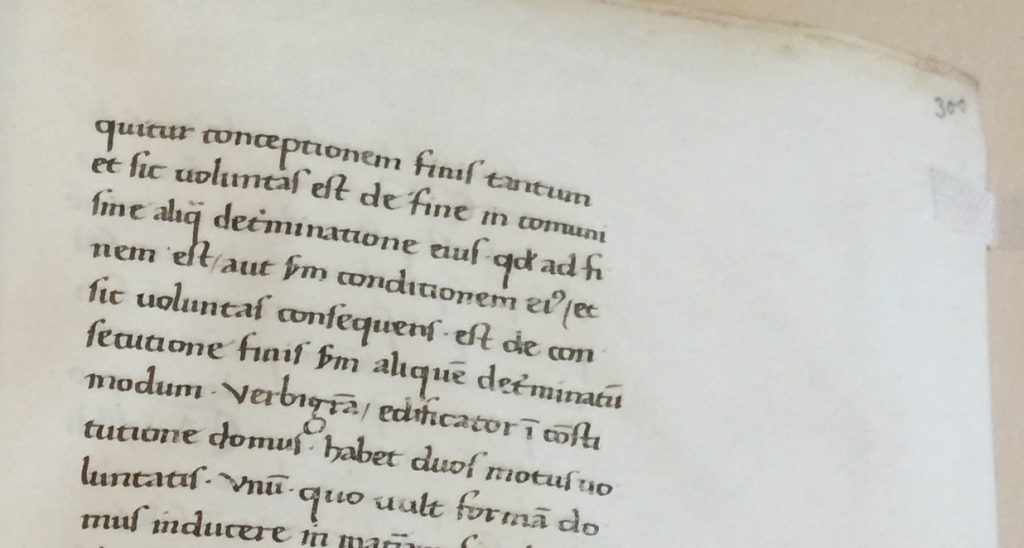
Private Collection, FBNC, Aquinas Leaf ‘Back’ top right and page number. Reproduced by permission.
Who can tell, at present, if the slight difference in counting by 1 leaf between the catalogues (Davis & Orioli versus the ‘American’) represents a simple typographical mistake. Or a divergent or inconsistent approach to including manuscript leaves and endleaves?
But more, could it signify the removal of 1 leaf between the time of the Davis & Orioli sales catalogues (1925–1926) and the arrival of the manuscript in the hands of a next bookseller (name as yet unidentified), perhaps in America, by an American, or by a vendor aiming for the American market? Would a removal have claimed a folio deemed desirable to retain for one reason or other, or have extracted a folio especially damaged and unsightly?
It is worth wondering whence Ege acquired his varying assessments of the date of production of the manuscript as “1470”, tout court, and as “Late XVth Century” (see above). Would the manuscript have had a colophon or some other evidence for the cited date? Would the assessment depend upon the catalogue(s) through which, and travelling with which, the manuscript came to Ege? More research might reveal the answers.
More to Come
The next blogpost in our series on Ege Manuscript 40 examines more parts of the manuscript. The pair of specimens in the “Ege Family Portfolio” (FOL Set 3) contain significant evidence of its former character, decoration, and ownership.
Among these signs are the owner’s arms within a wreath. In the image painted on the page, we can see for ourselves its rendering of the heraldic design, including the shapes and locations of the elements in gold (or), as precisely described in sales catalogues:
azure, 3 crescents or between a chevron of the same
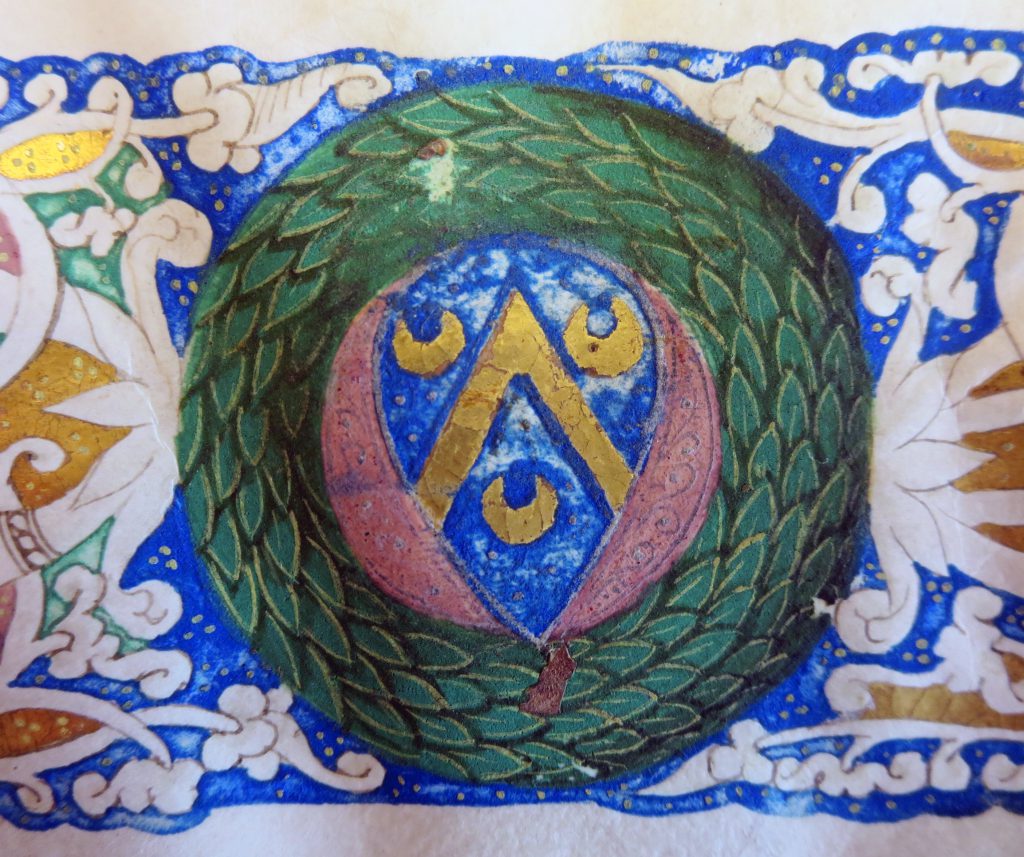
Beinecke Rare Book & Manuscript Library, Otto Ege Collection, FOL Set 3, MS 40, Specimen 1 = folio ‘1’r, bottom center. Photography Mildred Budny.
*****
We thank the owner of the ‘new’ Portfolio and the owners of other specimens for permission to examine them. We are grateful for permission to reproduce the images. Thanks, as always, for the advice, encouragement, and suggestions of colleagues, students, and friends!
*****
Do you know of other leaves from this Aquinas manuscript? Other Sets of the Portfolio of Famous Books in Nine Centuries (FBNC), or Sets of the Fifty Original Leaves (FOL)?
Do you recognize the work of the scribe(s) in other manuscripts? Do you recognize the owner’s arms?
Please let us know. Please leave your Comments here, Contact Us, and/or visit our Facebook Page. We look forward to hearing from you.
Next stop, Part III:
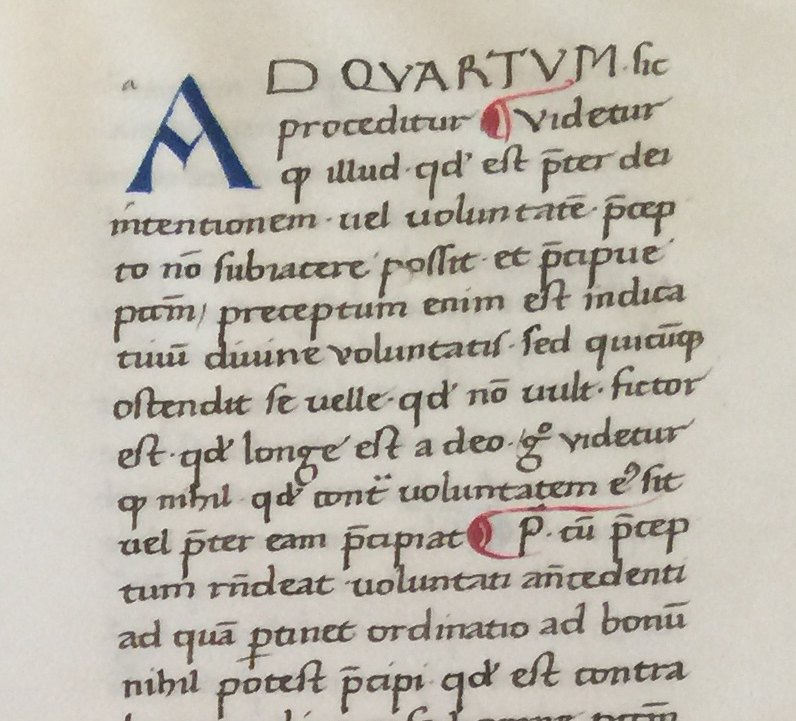
Private Collection, Ege’s FBNC Portfolio, Aquinas Leaf, Recto, Top Right. Reproduced by Permission.
*****
